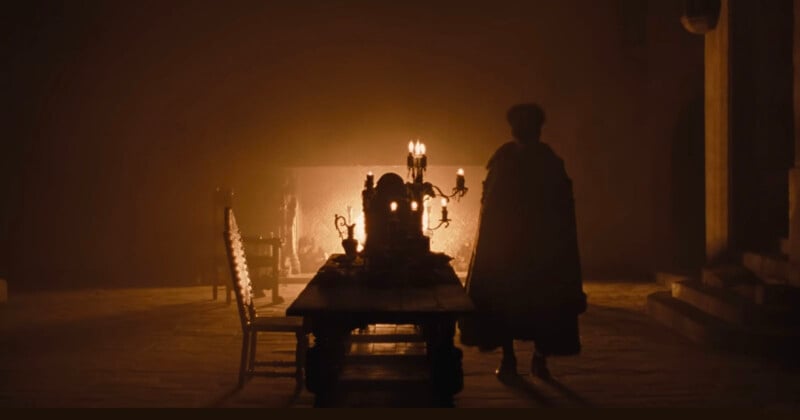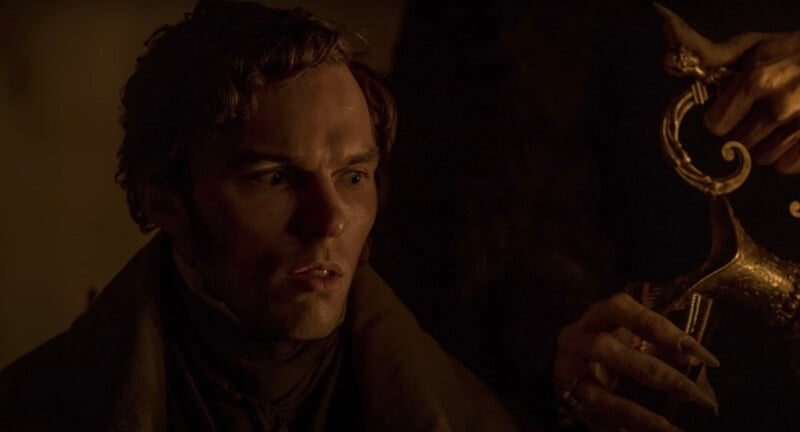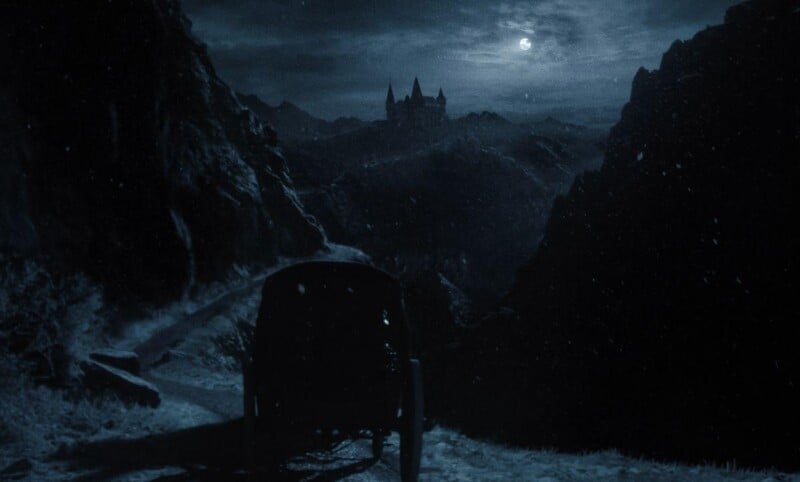 Count Orlok appears in the Great Hall silhouetted by the only light source in the room: the fire.
Count Orlok appears in the Great Hall silhouetted by the only light source in the room: the fire.Nosferatu by Roert Eggers is cinematography treat. Shot entirely on film, the Dracula movie uses candlelight and firelight to create unnerving scenes that are truly masterful in their execution.
The film’s cinematographer Jarin Blaschke who previously worked alongside Eggers on The Witch, The Lighthouse, and The Northman reveals to Variety some of the techniques used for perhaps the movie’s most compelling scene: when Thomas Hutter, played by Nicholas Hoult, goes to the castle to meet with Count Orlok who is played by Bill Skarsgård.
“Being disoriented and having the camera lead you, and you’re never really sure what you’re going to look at next is an important aspect of this film,” Blaschke says of the unnerving encounter which is a confusing experience for the audience.
Playing with hidden details in the shadows, Orlok is introduced very slowly and is often just a silhouette standing ominously in the distance. Orlok leads Hutter up to the Great Hall of the castle which is lit by a single fire.
“I’m creative but in lighting, I tend to be a little bit literal,” Blaschke tells Variety. “If there’s a fire in the room I’m just going to choose where the fire is going to be and embellish it but still from the same direction.”
“Everything is motivated from that direction so you’re still believing there’s real fire,” he continues. “There’s no electric light in the Great Hall, it’s all done by fire. If I want some more I’ll put some mirrors and I’ll multiply the source.”
During this scene, Blaschke uses clever tricks to keep Orlok present without revealing his face. Orlok will appear out of focus or silhouetted by the fire but then suddenly appears to pour a drink into Hutter’s chalice; keeping the audience on tenterhooks.
At one stage, Blaschke considered putting bulbs in the fireplace to increase the amount of available light but ultimately decided to use mirrors or simply turn the fire up a little.
 This still is a perfect example of the crosslighting effect made by the fire on one side of the room and mirrors on the other.
This still is a perfect example of the crosslighting effect made by the fire on one side of the room and mirrors on the other.Shooting firelit scenes on film is no mean feat. Using 35mm Kodak Vision3 500T negative film in Arri ST cameras, Blaschke turned to Panavision’s senior vice president of optical engineering Dan Sasaki for the right lenses to pull it off. Sasaki is often described as the guru of optics and helped create unique lenses for Oppenheimer.
“You need a focus puller who can deal with it because we’re not just using static shots in this film, we have people moving through space, and the depth of field, when you’re at those light levels, is extremely thin.” Blaschke tells Variety.
“Sometimes it’s a centimeter on a shot that’s this big. So you can’t take that lightly. I happen to have one of the best focus pullers in the world who’s willing to work with me. I met him on The Northman and he could handle these scenes.”
Outside of the scene in the Great Hall, Blaschke used some LED and HMI lighting; the latter was used to create the impression of natural light. The moonlight shots of Hutter approaching the castle were almost devoid of color and that is partly because there is no red information on the negative.
 The moonlit shots contain no red information at all,
The moonlit shots contain no red information at all,“Your film has three layers of color, there is no red at all. There is a little green, the blue layer is doing most of the heavy lifting,” Blaschke explains. “If you print it red to get your red back there is no red to be had — it just kind of goes grey. And the idea is that it’s not a tone it’s literally not there.”
Blaschke says that he is as satisfied with Nosferatu as any film he’s done previously. Noseferatu is playing in theaters now.
Image credits: Focus Features






 English (US) ·
English (US) ·